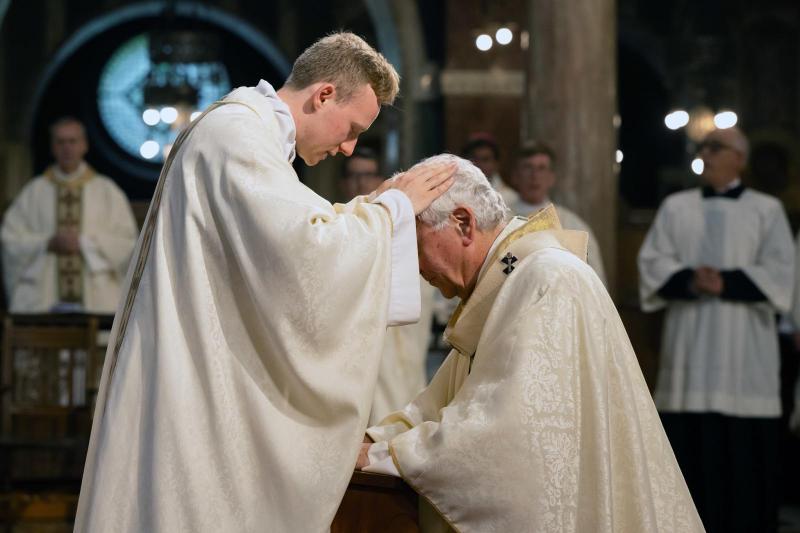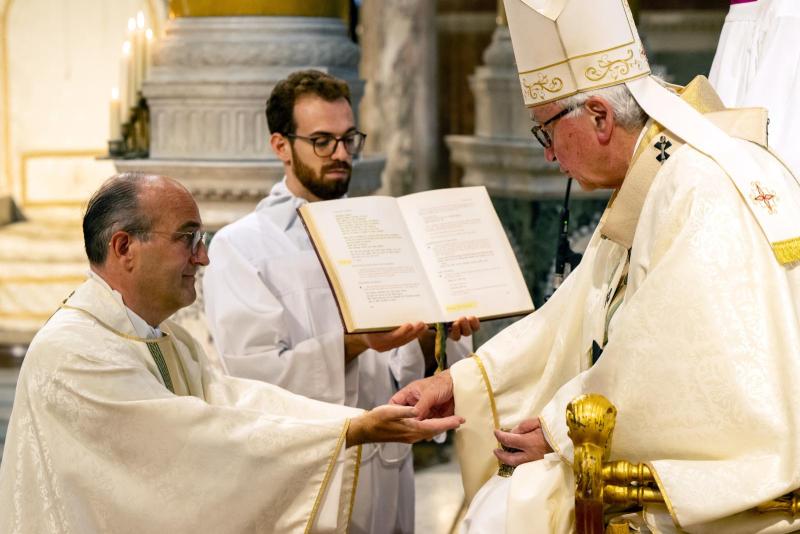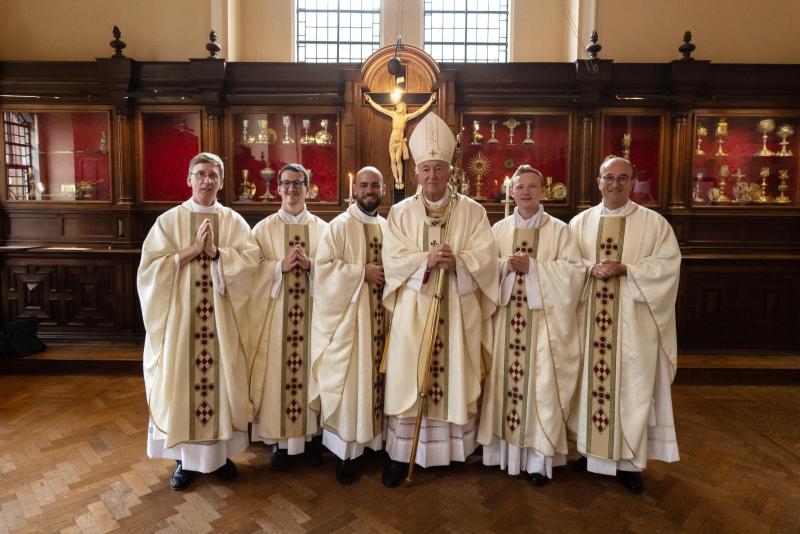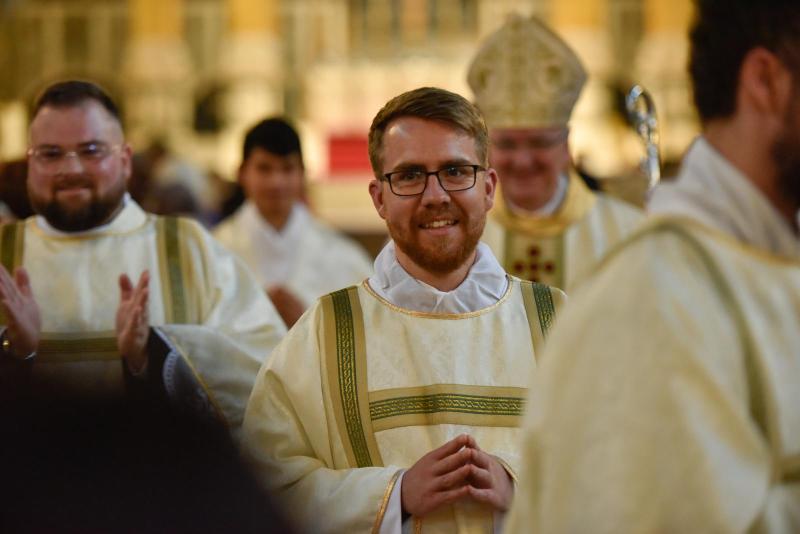Introduction Paul Shaw, SMG Central Congregational Archivist
We are very pleased to be able to offer a previously unpublished article by Frances Margaret Taylor (in religion Mother Magdalen Taylor), in which, late in life, she discusses some of the formative influences which were eventually to lead her to convert from the Church of England to the Roman Catholic faith, going on to found a new religious congregation in the Catholic Church in 1872. This is remarkable because Mother Magdalen seldom referred in print to her life before she became a Catholic, and left behind only a few precious fragmentary accounts of her early life and family.
In this prefatory note we will first provide a little historical context. The long street and unprepossessing church referred to in the first sentence of Mother Magdalen’s account were identified by the late Sr Rose Joseph SMG some years ago: the church is the one formerly known as Christ Church, (now the Antiochian Orthodox Cathedral of St George); and the lengthy street, Albany Street, leading from the busy Euston Road north to Camden Town. It is a street mainly of elegant and imposing early nineteenth century town houses, and would easily be recognised by Mother Magdalen if she were to visit today, despite the presence of some less harmonious modern intrusions.
Various parties of SMG Sisters and supporters have been made welcome in the church over the years, and on one of the galleries is a later stained glass window (below, right) erected to the memory of Mother Magdalen’s own mother, Louisa Maria Taylor who became a dedicated worshipper there, as reflected in her diary. The former Christ Church, erected in 1837, is a forerunner of the many large and imposing churches built from the 1830s onwards as an expression of the influence of the growing Oxford or Tractarian (later Anglo-Catholic) Movement in the Anglican Church. The movement was to have as its defining characteristics a new fervency in religious belief and practice; an emphasis on service to the poor and their inclusion in the worshipping community; and a new dedication to the beautification of parish churches, as part of a renewed ideal of sacramental worship. The impact on the Taylor family, only recently moved to London following the death of Louisa’s husband, Rev Henry Taylor, was profound, in particular on Frances’s elder sisters, Emma, Lucy and Charlotte.
Christ Church was a pioneer in the movement; and as Mother Magdalen herself says, the church interior in her day (from c.1844-1854) was remarkably plain, as was the case with most Anglican churches of the day, where any gesture towards colour and symbolism was generally regarded with great suspicion as being contrary to principles of a Protestant church. The church of St Michael’s Shoreditch referred to in the accompanying note by Sr Mary Campion, which is a monumental and elaborate neo-Gothic structure, reflects the typical pattern of Anglo-Catholic worship and aesthetics as they developed later in the nineteenth century. The ‘Margaret Chapel’ also referred to by Sr Campion, later became the church of All Saints, Margaret Street, another London Anglo-Catholic stronghold. Following Mother Magdalen’s conversion to Catholicism, her mother continued to worship in the church, probably until her death in 1869, and frequently expressed her admiration for the vicar, Rev Burrows, who became conversion to Catholicism of the incumbent, Rev William Dodsworth (1798-1861).
Mother Magdalen’s account is also a testimony to the influence upon her of particular individuals connected with the Oxford Movement, who impressed her by their piety, fervour and powers of leadership. Rev Dodsworth, in particular, though little remembered nowadays, was a very notable figure amongst the early Tractarian leaders in London. Rev Burrows later wrote a history of the church in which he said:
‘Mr Dodsworth was a man of great devotion and force of character, influencing others deeply by his own earnestness, with a clear head, telling eloquence, and fine effective voice…When the plans for building a church in Albany Street were maturing, Mr Dodsworth’s was the most powerful spiritual influence on that part of London. His appointment…as Perpetual Curate for the rising church assured the success of the undertaking.’
In addition to the fervency, regularity and relative plainness of early Tractarian worship, Rev Burrows’ account also emphasises the importance placed on service to the weak and vulnerable, and it is noted that ‘the temporal relief of the poor was from the first earnestly taken in hand’, mainly through a series of provident and charitable clubs and societies, and it was said to be the first Anglican parish where district visitors were employed amongst the London poor. This dedication to the poor also led to the building of a new church in the southern part of the parish, St Mary Magdalene, Munster Square, still serving as the Anglican parish church for the neighbourhood. The first minster of the mission was Rev Edward Stuart, one of the leading lights of the next phase of Anglo-Catholicism. The locality of the new church was dominated by poverty and prostitution, the latter partly due to the nearby army barracks.
Though she does not mention Rev Stuart, whom she must certainly have known, Mother Magdalen does mention two other clergymen who has a profound influence upon her: the Rector of Holy Trinity Church, Brompton, Dr W.J. Irons, where the Taylor family first came under the influence of the Oxford Movement, on first moving to London; and the young Rev Gordon, whose eloquent preaching clearly made a particular impact on her. It is remarkable to note that this curate, John Joseph Gordon, whom she notes became a priest of the Birmingham Oratory, was later to be the dedicatee of his superior J.H. Newman’s famous poem, ‘The Dream of Gerontius’. Mother Magdalen herself was to be the first to publish it, as editor of the journal which she later founded, The Month.
Rev Dodsworth was received into the Catholic Church on the last day of 1850, and some claimed that the so-called ‘Gorham Judgement’ was the main reason for his conversion, whilst others thought him also to have been influenced by ‘the devout John Gordon’ who preceded him. Certainly, Mother Magdalen’s emphasis in her article on the sacrament of baptism is very significant. By the ‘Gorham Judgement’ of 1850, which she refers to, it was made plain that in the Church of England, sacraments such as baptism could be regarded by its clergy in a strictly symbolic rather than a spiritual sense, and that a civil court could pronounce a final ruling on church doctrine. The Oxford Movement was, in its origins, a theological movement which taught that the Church was a Divine Society founded on the teaching and ministry of the Apostles. If the Church of England was, in actual fact, merely an institution of the state, which has to bow to the doctrinal dictates of the organs of British civil society, many of its clergy (including Rev Dodsworth and Mother Magdalen’s later friend and supporter Archdeacon – later Cardinal Manning) concluded that it could not therefore be part of the One Holy Catholic and Apostolic Church, and that they must therefore, in conscience, join the Roman Catholic Church.
We can thus see that at Christ Church, Albany Street, Mother Magdalen, at a formative age, came firmly under the influence of the Oxford Movement, and the sacramental and sacrificial ideal which it represented. This was eventually to lead many of Mother Magdalen’s high ideals to the Roman Catholic faith, including her own sister Charlotte; they had concluded that the aspirations and spiritual values of the movement could be achieved within the Church of England, but only in the Catholic Church. Those who remained in the Church of England – including Mother Magdalen’s mother Louisa and her sisters Lucy and Emma – helped to ensure by their labour and aspiration that the Anglo-Catholic movement was to have a vital and formative influence on the future of the Church of England itself, not least in the re-establishment within it of religious orders of men and women.
It is interesting, however, that Mother Magdalen does not mention in her article one very significant fact: that Christ Church itself was the place where this extraordinary experiment began (though she does refer to Catholic converts from the Sisterhood). To many, the origins of the Church of England were inextricably linked with Henry VIII’s ‘Dissolution of the Monasteries’, and the attempt to re-establish the religious life in the Church of England was inevitably attended by much controversy. But in 1845, the first Anglican Sisterhood (the Sisterhood of the Holy Cross) was founded at Park Village West, near to Christ Church, and under the spiritual guidance of Rev Dodsworth. Letters recently discovered in the SMG Archives show that Mother Magdalen, as a teenager, was worshipping with these sisters and visiting their orphanage in Upper Albany Street. The Sisterhood was clearly established as an extension of the church’s outreach and service to the poor, and the sisters’ work included showing hospitality to indigents, providing schooling for the poor, and visiting the poor in their own homes. The object of the community was stated as ‘to grow in the love of Jesus Christ, apart from the distractions of the world, especially by cherishing and showing forth love to Him in His poor and afflicted brethren’, and six hours a day was supposed to be spent by each member of the Sisterhood in this work.
In October 1848, Emma and Charlotte Taylor had become aspirants of another Anglican Sisterhood, the Sisters of Mercy of the Holy Trinity (Devonport), on its foundation by the controversial Priscilla Lydia Sellon; they were very probably influenced, like Mother Magdalen, by the presence at Christ Church of the so– called ‘Park Village Sisters’ and the model of religious life which they represented. In 1852, Mother Magdalen joined them as an aspirant to Miss Sellon’s order, staying for perhaps two years, but like her sister Charlotte, she was eventually to realise that her vocation lay elsewhere; Emma, however, remained as a devoted member of this community until her death in 1890. As is well known, the next vital stage in Mother Magdalen’s journey to her vocation was her service as a nurse in the Crimean War hospitals, where she was herself to become one of the ‘Batch of Converts’ whose spiritual journey was shaped by their attendance at Christ Church, Albany Street.
Undoubtedly, the nobly Christian ideal which Mother Magdalen imbibed there, and its practical expression in the service of the poor, was to reach its fulfilment in the Catholic Church – her own ‘true fold’, - and in the founding of the Poor Servants of the Mother of God.
‘A Batch of Converts, by one of Them’
(A Fragment of Memoir by Mother Magdalen Taylor)
Now that I am old, memory brings before me many incidents of the past. I see a long street in London and in the middle, a large and ugly church. Inside, it is very unadorned. It is filled with pews – not huge erections that I remember in country churches – with curtains running on brass rods at the top behind which the squire and the rich farmers could comfortably doze out the sermon – but still, high pews with doors, and cushions and little boxes for prayer books.
At the east end a table covered by a crimson cloth – two candlesticks on it. We had not in those days advanced as far as a cross. But all was very clean and neat and there was a certain air of devotion about the place, unmistakeably so at service time – those services were devoutly led and heartily responded to by the congregation.
The incumbent was the Rev W. Dodsworth, a man of rugged aspect, cold manners, but gifted with a warm heart and extreme earnestness of purpose. He loved his flock and tried to teach them. That flock did not consist only of those who lived near and who were ‘in his district’, but of many who came from afar to listen to him on Sunday mornings, when he preached he had a happy knack of weaving into his discourse all the striking public events of the preceding week – teaching people; as some said, how to think.
But my memories are more bound up with the Fridays in Lent when there was always a stirring service and a sermon. The church was close to the Regent’s Park, and I can now see the little groups that dotted the greensward as they wended their way from St. John’s Wood, Camden Town and other parts –for services such as these were few and far between in the London of those days. Mr Dodsworth had three curates all of whom took their turn in preaching. The favourite with us youngsters was Mr. Gordon, who was very interesting looking and had a beautiful voice. I remember his text one Friday – ‘Out of the depths have I cried to Thee O Lord; Lord hear my voice’. His voice was like a silver bell and it still rings in my ears. Many indeed were, like Mr. Gordon himself, crying from ‘Out of the depths’ and their cry was heard He was the first to pass into the light. He became a priest of the Birmingham Oratory and soon after died a saintly death. He was such a lovable character that old friends did not drop him after conversion as is usually the case in England –I can remember hearing an Anglican parson speak of his deathbed ‘His last words, I am told,’ said he,‘were “Jesus, Mary”; Oh if only he had not said Mary!’.
One or two members of the Congregation followed Mr. Gordon and then came the Gorham Judgement –which decided that the doctrine of
Baptismal Regeneration was not contained in the ‘Thirty–Nine Articles’, Prayer Book, or any of the formularies of the Church of England and therefore need not be held by her ministers. This was too much for Rev. Dodsworth– he became a Catholic with his wife and two daughters, both of whom became nuns later on. Followed by Mr New, the senior curate, with his wife and large family. One of his sons became a priest, and one daughter a nun. Ina after years a grandson became a Benedictine monk.
Of the Sisters under Mr. Dodsworth’s direction –the Superior and three others became Catholics and two of these, nuns; several ladies of the congregation also entered religion – one went to Carmel – two to the Canonesses of the Holy Sepulchre – others to the Good Shepherd – Poor Servants of the Mother of God and the Dames du Sacré Coeur – and Perpetual Adoration Orders.
The junior curate Mr Garside became a priest; still later another curate of this church entered the priesthood, and yet another with his wife became devout Catholics.
But there was a group among the worshipers to whom special interest attaches. In the days of the first Carlist war in Spain, a nobleman of the lost cause took refuge in England, gave up his faith and became engaged to a Protestant lady. A difficulty arose as to their marriage. If Count A– was married by any but a Catholic priest, his marriage would be held invalid by the laws of Spain and his children could never inherit his property. But it was no easy task to get a Catholic priest to join the couple. One Irish Father to whom they applied answered, ‘certainly not, I look on ye as nothing better than a pair of haythens!’At last, however, an exiled Spanish priest tied the knot. Count A– had three sons who were brought up as Protestants, and the eldest was sent to Oxford. There he found ‘the Oxford Movement’ in full progress. He soon became very High Church, married and settled near Christ Church, Albany Street, and soon after Mr Dodsworth’s conversion, this gentleman with his wife, three boys and two girls were all received into the Church. One of these children became a Jesuit.
After a time, it is supposed in answer to the constant and earnest prayers of his grandchildren, Count A– now an old man, came back to the faith of his fathers and having done so became a fervent penitent. His hardest cross was that by his fault, his two younger sons were Protestants.
Mysterious are God’s ways! He was allowed to suffer this trial and bewail the consequences of his sin till death. Not long after he had passed away both of these sons were received into the One, True Church.
Our calculation may not be precise, but as far as memory serves our ‘Batch of Converts’ at that period from that one church stands somewhat like this, in its results:
Three secular priests;
An Oratorian;
A Jesuit;
A Benedictine;
Two Canonesses of the Holy Sepulchre;
One nun of the Good Shepherd;
Two of the Perpetual Adoration;
One Carmelite;
One Poor Servant of the Mother of God;
Two nuns of the Sacred Heart;
Two Sisters of Charity;
From thirty to forty lay persons.
I have yet another remembrance of still earlier days –I was very fond of being present at Baptisms and the incumbent of Holy Trinity Church, Brompton [Dr Irons], had a most effective manner of performing the ceremony. He took each baby into his arms as if it were the only one in the world and baptised it slowly and carefully, so much so that when the father of some of these favoured infants became a Catholic he offered to affirm on his oath that he had seen his children duly baptised, and therefore conditional baptism was not given to them.
One Christmas great excitement was caused about a baptism to take place on Holy Innocents’ Day. The two babies were first cousins and only a few days old, but in defiance of the old fashion that forbade babies going to church without their mother, the Feast of Holy Innocents was not to be missed. So the ceremony took place. How little did I dream then, as I watched those two receive Holy Baptism, of my own conversion and vocation to the Religious Life, or that Clement, duly baptised, would be a Jesuit, and Sophia Magdalen, a Sister of Charity.
Now, most of them of whom I have spoken have passed to their eternal home. May their prayers strengthen our feeble ones on earth and win grace for those who are still crying from ‘Out of the depths’ so that they too may pass into the light of the true fold.



